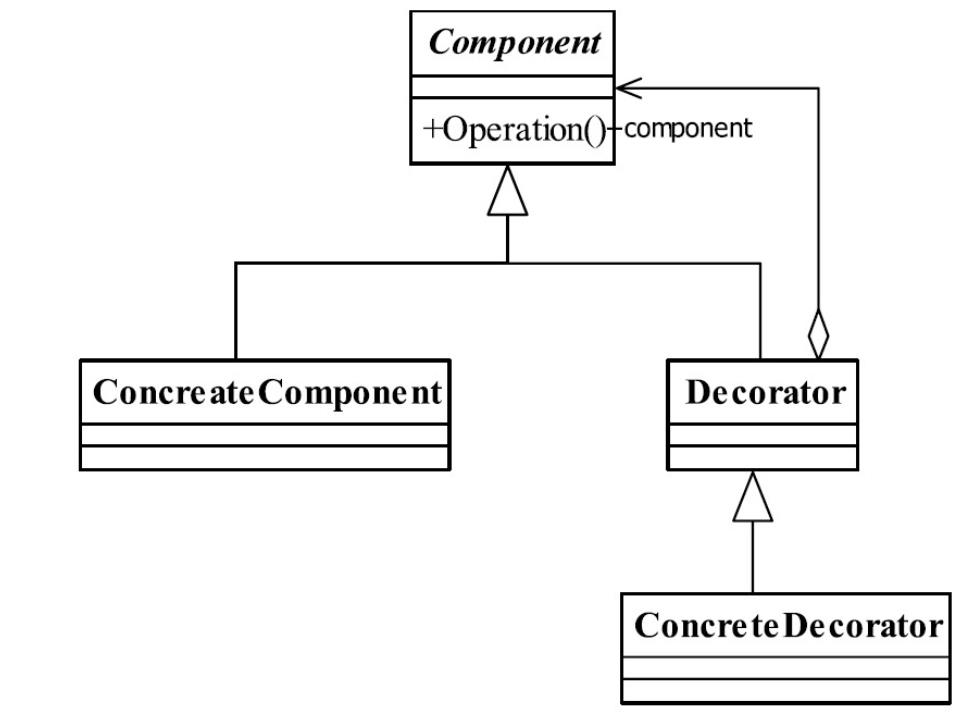[设计模式C++go]结构型模式:装饰器模式
Posted 凌星An
tags:
篇首语:本文由小常识网(cha138.com)小编为大家整理,主要介绍了[设计模式C++go]结构型模式:装饰器模式相关的知识,希望对你有一定的参考价值。
文章目录
装饰器模式
介绍
装饰器模式(Decorator Pattern)允许向一个现有的对象添加新的功能,同时又不改变其结构。这种类型的设计模式属于结构型模式,它是作为现有的类的一个包装。
这种模式创建了一个装饰类,用来包装原有的类,并在保持类方法签名完整性的前提下,提供了额外的功能。
其定义为:
装饰模式(Decorator Pattern)是一种比较常见的模式,其定义如下: Attachadditional responsibilities to an object dynamically keeping the same
interface.Decorators provide a flexible alternative to subclassing for extendingfunctionality.(动态地给一个对象添加一些额外的职责。就增加功能来说,装饰模式相比生成子类更为灵活。)
意图: 动态地给一个对象添加一些额外的职责。就增加功能来说,装饰器模式相比生成子类更为灵活。
主要解决: 一般的,我们为了扩展一个类经常使用继承方式实现,由于继承为类引入静态特征,并且随着扩展功能的增多,子类会很膨胀。
何时使用: 在不想增加很多子类的情况下扩展类。
如何解决:
将具体功能职责划分,同时继承装饰者模式。
关键代码:
1、Component 类充当抽象角色,不应该具体实现。
2、修饰类引用和继承 Component 类,具体扩展类重写父类方法。
类图

Component:是一个接口或者是抽象类,是最核心的对象,也是最原始的对象.
注: 在装饰模式中,必然有一个最基本、最核心、最原始的接口或抽象类充当为Component
ConcreteComponent: 实现Component类
Decorator:装饰类
实现新功能的接口或者抽象类,在它里面必然有一个Component变量
ConcreteDecorator:具体的装饰类
代码实现:
现在学校发布了成绩单,有数学语文成绩和班级排名;自己的成绩语文成绩有点惨烈只有50分,数学优,得了98分,排名为30;如果把这份成绩如实给父母的话,有点不好,因此装饰了一下成绩单,只给父母说排名和最高成绩.
C++
class GradeReportComponent
public:
virtual std::string Report() = 0;
int _chinese;
int _math;
int _num;
;
class GradeReportConcreteComponent:public GradeReportComponent
public:
GradeReportConcreteComponent(int chinese, int math, int num)
_chinese = chinese;
_math = math;
_num = num;
//学校成绩单
std::string Report()
return "语文: " + std::to_string(_chinese) + "\\n数学: " + std::to_string(_math) + "\\n排名:" + std::to_string(_num);
;
class GradeReportDecorator :public GradeReportComponent
public:
virtual std::string Report() = 0;
protected:
GradeReportComponent* _GR;
;
class GradeReportConcreteDecorator :public GradeReportDecorator
public:
GradeReportConcreteDecorator(GradeReportComponent* GR)
_GR = GR;
//自己装饰后的成绩单
std::string Report()
return GetHighestScore();
private:
std::string GetHighestScore()
std::string str = "";
if (_GR->_chinese > _GR->_math)
str += "语文: " + std::to_string(_GR->_chinese);
else
str += "数学: " + std::to_string(_GR->_math);
str += "班级排名: " + std::to_string(_GR->_num);
return str;
protected:
GradeReportComponent* _GR;
;
测试:
GradeReportConcreteComponent* GR = new GradeReportConcreteComponent(50, 98, 30);
cout << GR->Report() << endl;
cout << "修饰一下成绩" << endl;
GradeReportDecorator* GRD = new GradeReportConcreteDecorator(GR);
cout << GRD->Report() << endl;
结果:
语文: 50
数学: 98
排名:30
修饰一下成绩
数学: 98班级排名: 30
Go
package Decorator
import "strconv"
type GradeReportComponent interface
Report() string
type GradeReportConcreteComponent struct
Chinese, Math, Num int
func (g *GradeReportConcreteComponent) Report() string
return "语文: " + strconv.Itoa(g.Chinese) + "\\n数学: " + strconv.Itoa(g.Math) + "\\n排名:" + strconv.Itoa(g.Num)
这里和GradeReportComponent相同,为了和类图相匹配,没有删掉
type GradeReportDecorator interface
Report() string
type GradeReportConcreteDecorator struct
GR *GradeReportConcreteComponent
func (g *GradeReportConcreteDecorator) Report() string
var str string
if g.GR.Chinese > g.GR.Math
str += "语文: " + strconv.Itoa(g.GR.Chinese)
else
str += "数学: " + strconv.Itoa(g.GR.Math)
str += "\\n排名:" + strconv.Itoa(g.GR.Num)
return str
测试
var g Decorator.GradeReportComponent
tmp := Decorator.GradeReportConcreteComponent50, 98, 30
g = &tmp
fmt.Println(g.Report())
fmt.Println("装饰成绩")
var d Decorator.GradeReportDecorator
d = &Decorator.GradeReportConcreteDecorator&tmp
fmt.Println(d.Report())
结果:
语文: 50
数学: 98
排名:30
装饰成绩
数学: 98
排名:30
优缺点
优点:装饰类和被装饰类可以独立发展,不会相互耦合,装饰模式是继承的一个替代模式,装饰模式可以动态扩展一个实现类的功能。
缺点:多层装饰比较复杂。
使用场景: 1、扩展一个类的功能。 2、动态增加功能,动态撤销。
注意事项:可代替继承。
以上是关于[设计模式C++go]结构型模式:装饰器模式的主要内容,如果未能解决你的问题,请参考以下文章